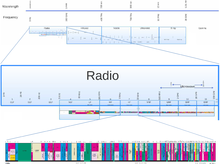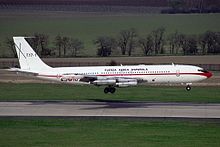High frequency
Frequency range | 3 to 30MHz |
|---|---|
Wavelength range | 100 to 10 m |
| Radio bands | ||||||||||||
|---|---|---|---|---|---|---|---|---|---|---|---|---|
| ITU | ||||||||||||
|
||||||||||||
| EU / NATO / US ECM | ||||||||||||
| IEEE | ||||||||||||
| Other TV and radio | ||||||||||||

High frequency(HF) is theITUdesignation[1]for thebandofradio waveswithfrequencybetween 3 and 30megahertz(MHz). It is also known as thedecameter bandordecameter waveas itswavelengthsrange from one to tendecameters(ten to one hundred meters). Frequencies immediately below HF are denotedmedium frequency(MF), while the next band of higher frequencies is known as thevery high frequency(VHF) band. The HF band is a major part of theshortwaveband of frequencies, so communication at these frequencies is often calledshortwave radio.Because radio waves in this band can be reflected back to Earth by theionospherelayer in the atmosphere – a method known as "skip" or "skywave"propagation – these frequencies are suitable for long-distance communication across intercontinental distances and for mountainous terrains which preventline-of-sightcommunications.[2]The band is used by international shortwave broadcasting stations (3.95–25.82 MHz), aviation communication, government time stations, weather stations,amateur radioandcitizens bandservices, among other uses.
Propagation characteristics[edit]

The dominant means of long-distance communication in this band isskywave( "skip" ) propagation, in which radio waves directed at an angle into the skyrefractback to Earth from layers ofionizedatoms in theionosphere.[3]By this method HF radio waves can travel beyond the horizon, around the curve of the Earth, and can be received at intercontinental distances. However, suitability of this portion of the spectrum for such communication varies greatly with a complex combination of factors:
- Sunlight/darkness at site of transmission and reception
- Transmitter/receiver proximity to solarterminator
- Season
- Sunspot cycle
- Solar activity
- Polar aurora
At any point in time, for a given "skip" communication path between two points, the frequencies at which communication is possible are specified by these parameters:
- Maximum usable frequency(MUF)
- Lowest usable high frequency(LUF) and a
- Frequency of optimum transmission(FOT)
The maximum usable frequency regularly drops below 10 MHz in darkness during the winter months, while in summer during daylight it can easily surpass 30 MHz. It depends on the angle of incidence of the waves; it is lowest when the waves are directed straight upwards, and is higher with less acute angles. This means that at longer distances, where the waves graze the ionosphere at a very blunt angle, the MUF may be much higher. The lowest usable frequency depends on the absorption in the lower layer of the ionosphere (the D-layer). This absorption is stronger at low frequencies and is also stronger with increased solar activity (for example in daylight); total absorption often occurs at frequencies below 5 MHz during the daytime. The result of these two factors is that the usable spectrum shifts towards the lower frequencies and into theMedium Frequency(MF) range during winter nights, while on a day in full summer the higher frequencies tend to be more usable, often into the lowerVHFrange.[citation needed]
When all factors are at their optimum, worldwide communication is possible on HF. At many other times it is possible to make contact across and between continents or oceans. At worst, when a band is "dead", no communication beyond the limitedgroundwavepaths is possible no matter what powers,antennasor other technologies are brought to bear. When a transcontinental or worldwide path is open on a particular frequency,digital,SSBandMorse codecommunication is possible using surprisingly low transmission powers, often of the order of milliwatts, provided suitable antennas are in use at both ends and that there is little or noartificialornatural interference.[4]On such an open band, interference originating over a wide area affects many potential users. These issues are significant to military, safety[5]andamateur radiousers of the HF bands.
Uses[edit]



The main uses of the high frequency spectrum are:
- Military and governmental communication systems
- Aviation air-to-ground communications
- Amateur radio
- Shortwaveinternational and regional broadcasting
- Maritime sea-to-shore and ship-to-ship services
- Over-the-horizon radarsystems
- Global Maritime Distress and Safety System(GMDSS) communication
- Citizen's Band Radioservices worldwide (generally 26-28 MHz, the higher portion of the HF band, that behaves more like low-VHF)
- Coastal ocean dynamics applications radar
The high frequency band is very popular withamateur radiooperators, who can take advantage of direct, long-distance (often inter-continental) communications and the "thrill factor" resulting from making contacts in variable conditions. Internationalshortwavebroadcasting utilizes this set of frequencies, as well as a seemingly declining number of "utility" users (marine, aviation, military, and diplomatic interests), who have, in recent years, been swayed over to less volatile means of communication (for example, viasatellites), but may maintain HF stations after switch-over for back-up purposes.
However, the development ofAutomatic Link Establishmenttechnology based on MIL-STD-188-141 for automated connectivity and frequency selection, along with the high costs of satellite usage, have led to a renaissance in HF usage in government networks. The development of higher speed modems such as those conforming to MIL-STD-188-110C which support data rates up to 120 kilobit/s has also increased the usability of HF for data communications and video transmission. Other standards development such asSTANAG5066 provides for error free data communications through the use ofARQprotocols.
Some modes of communication, such ascontinuous waveMorse codetransmissions (especially byamateur radiooperators) andsingle sidebandvoice transmissions are more common in the HF range than on other frequencies, because of their bandwidth-conserving nature, but broadband modes, such as TV transmissions, are generally prohibited by HF's relatively small chunk ofelectromagnetic spectrumspace.
Noise, especially man-made interference from electronic devices, tends to have a great effect on the HF bands. In recent years, concerns have risen among certain users of the HF spectrum over "broadband over power lines" (BPL)Internetaccess, which has an almost destructive effect on HF communications. This is due to the frequencies on which BPL operates (typically corresponding with the HF band) and the tendency for the BPL signal to leak from power lines. Some BPL providers have installed notch filters to block out certain portions of the spectrum (namely the amateur radio bands), but a great amount of controversy over the deployment of this access method remains. Other electronic devices including plasma televisions can also have a detrimental effect on the HF spectrum.
In aviation, HF communication systems are required for all trans-oceanic flights. These systems incorporate frequencies down to 2 MHz to include the2182 kHzinternational distress and calling channel.
The upper section of HF (26.5-30 MHz) shares many characteristics with the lower part of VHF. The parts of this section not allocated to amateur radio are used for local communications. These includeCB radiosaround 27 MHz, studio-to-transmitter (STL) radio links,radio controldevices for models and radio paging transmitters.
Some radio frequency identification (RFID) tags utilize HF. These tags are commonly known as HFID's or HighFID's (High-Frequency Identification).
Antennas[edit]
The most common antennas in this band are wire antennas such as wire dipoles orrhombic antennas;in the upper frequencies, multielementdipole antennassuch as theYagi,quad,andlog-periodic antennas.Powerful shortwave broadcasting stations often use large wirecurtain arrays.
Antennas for transmitting skywaves are typically made from horizontaldipolesor bottom-fed loops, both of which emithorizontally polarizedwaves. The preference for horizontally polarized transmission is because (approximately) only half of the signal power transmitted by an antenna travels directly into the sky; about half travels downward towards the ground and must "bounce" into the sky. For frequencies in the upper HF band, the ground is a better reflector ofhorizontally polarizedwaves, and better absorber of power fromvertically polarizedwaves. The effect diminishes for longer wavelengths.
For receiving,random wire antennasare often used. Alternatively, the same directional antennas used for transmitting are helpful for receiving, since most noise comes from all directions, but the desired signal comes from only one direction. Long-distance (skywave) receiving antennas can generally be oriented either vertically or horizontally since refraction through the ionosphere usually scrambles signal polarization, and signals are received directly from the sky to the antenna.
See also[edit]
- High-frequency Active Auroral Research Program
- High Frequency Internet Protocol
- Radio propagation
- Space weather
- Critical frequency
References[edit]
- ^"Rec. ITU-R V.431-7, Nomenclature of the frequency and wavelength bands used in telecommunications"(PDF).ITU. Archived fromthe original(PDF)on 31 October 2013.Retrieved28 January2015.
- ^Harmon, James V.; Fiedler, Ltc David M; Lam, Ltc Ret John R. (Spring 1994)."Automated HF Communications"(PDF).Army Communicator:22–26. Archived fromthe original(PDF)on 23 December 2016.Retrieved24 December2018.
- ^Seybold, John S. (2005).Introduction to RF Propagation.John Wiley and Sons. pp. 55–58.ISBN0471743682.
- ^Paul Harden (2005)."Solar Activity & HF Propagation".QRP Amateur Radio Club International.Retrieved2009-02-22.
- ^"Amateur Radio Emergency Communication".American Radio Relay League, Inc. 2008. Archived fromthe originalon January 29, 2009.Retrieved2009-02-22.
- ^Shoquist, Marc."The Antenna Coupler Program".VIP Club.
Further reading[edit]
- Maslin, N.M. "HF Communications - A Systems Approach".ISBN0-273-02675-5,Taylor & Francis Ltd, 1987
- Johnson, E.E., et al., "Advanced High-Frequency Radio Communications".ISBN0-89006-815-1,Artech House, 1997
- Narayanamurti, V.; Störmer, H. L.; Chin, M. A.; Gossard, A. C.; Wiegmann, W. (1979-12-31). "Selective Transmission of High-Frequency Phonons by a Superlattice: The" Dielectric "Phonon Filter".Physical Review Letters.43(27). American Physical Society (APS): 2012–2016.doi:10.1103/physrevlett.43.2012.ISSN0031-9007.
- Bejjani, Boulos-Paul; Damier, Philippe; Arnulf, Isabelle; Thivard, Lionel; Bonnet, Anne-Marie; Dormont, Didier; Cornu, Philippe; Pidoux, Bernard; Samson, Yves; Agid, Yves (1999-05-13)."Transient Acute Depression Induced by High-Frequency Deep-Brain Stimulation".New England Journal of Medicine.340(19). Massachusetts Medical Society: 1476–1480.doi:10.1056/nejm199905133401905.ISSN0028-4793.PMID10320386.
- Liu, H. C. (1991-05-15). "Analytical model of high-frequency resonant tunneling: The first-order ac current response".Physical Review B.43(15). American Physical Society (APS): 12538–12548.doi:10.1103/physrevb.43.12538.ISSN0163-1829.PMID9997055.
- Sipila, M.; Lehtinen, K.; Porra, V. (1988). "High-frequency periodic time-domain waveform measurement system".IEEE Transactions on Microwave Theory and Techniques.36(10). Institute of Electrical and Electronics Engineers (IEEE): 1397–1405.doi:10.1109/22.6087.ISSN0018-9480.
- Morched, A.; Marti, L.; Ottevangers, J. (1993). "A high frequency transformer model for the EMTP".IEEE Transactions on Power Delivery.8(3). Institute of Electrical and Electronics Engineers (IEEE): 1615–1626.doi:10.1109/61.252688.ISSN0885-8977.
External links[edit]
- Tomislav Stimac, "Definition of frequency bands (VLF, ELF... etc.)".IK1QFK Home Page (vlf.it).
- Douglas C. Smith,High Frequency Measurements Web Page; Index and Technical Tidbits.D. C. Smith Consultants, Los Gatos, CA.
- High Frequency Propagation Models,its.bldrdoc.gov.
- High Frequency Wave Propagation,cscamm.umd.edu.
- "High frequency noise"(PDF)
- "Advantages of HF Radio"Codan
- Solar conditions for HF-radio

